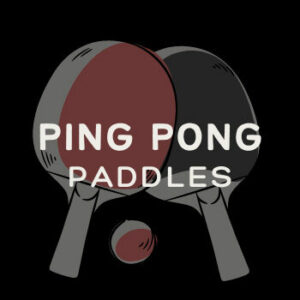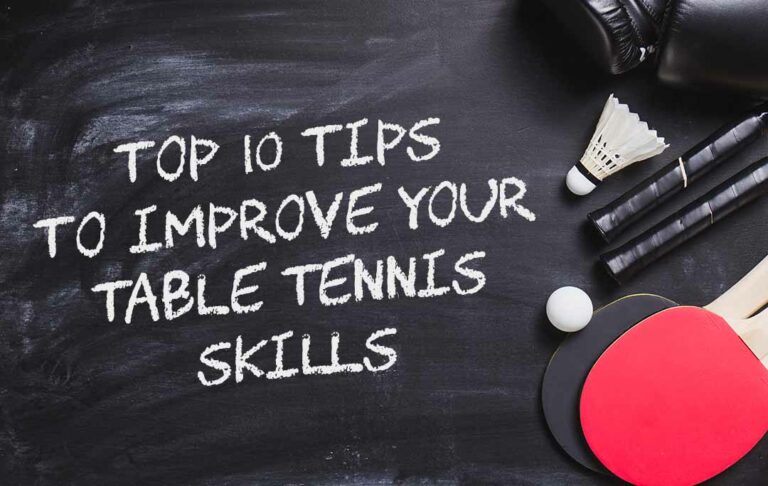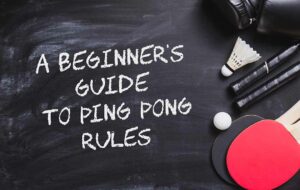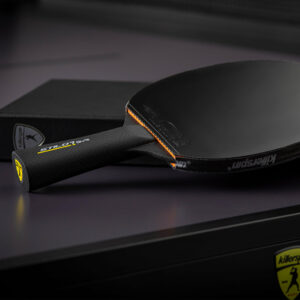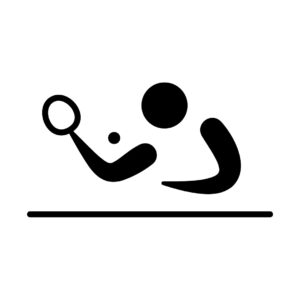10 Table Tennis Tips To Up Your Game
Table tennis, also known as ping-pong, is a fast-paced and exciting sport that requires agility, strategy, and precision.
Whether you are a beginner or an advanced player, there are always ways to improve your game and take it to the next level.
So here’s Rule Ping Pong‘s top table tennis tips.
In This article we will explore ten essential table tennis tips that can help you play like a pro.
From equipment to techniques, we will cover a wide range of aspects that can take your table tennis skills to new heights.
Get a decent paddle
One of the most fundamental aspects of table tennis is having the right equipment.
The first step towards becoming a better player is to invest in a decent paddle.
While there are different types of paddles available, it is important to find one that suits your playing style and skill level, and if you need help choosing, check our 10 picks for best beginner paddles and see what fits you.
A high-quality paddle will not only enhance your control and power but also improve your overall performance on the table.
When choosing a paddle, look for one with a comfortable grip and good balance.
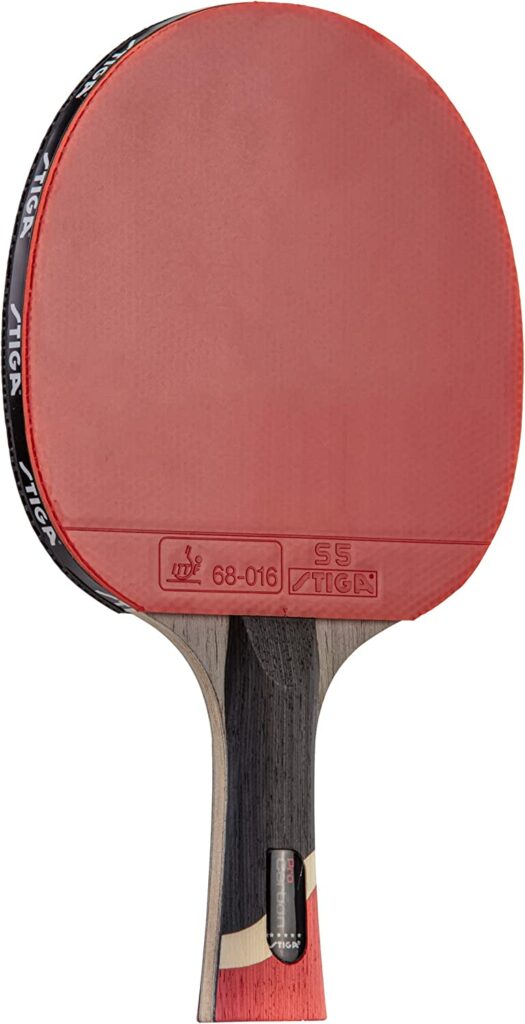
The surface of the paddle, commonly known as the rubber, should be sticky to generate spin and provide better ball control.
Additionally, consider the weight of the paddle, as it should be light enough to maneuver swiftly without sacrificing stability.
There are several factors to consider when selecting the right paddle for your game.
Firstly, you need to determine your playing style.
Are you an offensive player who prefers to attack aggressively, or are you more of a defensive player who focuses on counterattacking?
Your playing style will determine the type of paddle you should go for.
If you are an offensive player, you should look for a paddle that offers good speed and power.
These paddles usually have a thicker sponge and a harder rubber surface.
The increased sponge thickness provides more spring and speed, allowing you to generate powerful shots.
On the other hand, if you are a defensive player, you should opt for a paddle with a thinner sponge and a softer rubber surface.
This will give you better control and allow you to return your opponent’s shots with precision and accuracy.
Another important aspect to consider is your skill level.
If you are a beginner, it is advisable to start with a paddle that offers a good balance between control and power.
As you progress and improve your skills, you can gradually switch to a more specialized paddle that caters to your playing style.
In addition to the playing style and skill level, the grip of the paddle is crucial for comfortable and effective gameplay.
The grip should feel natural in your hand and allow for a firm hold without causing any discomfort or strain.
There are different types of grips available, such as the shakehand grip and the penhold grip.
The shakehand grip is the most common grip used by players and provides a versatile and stable hold on the paddle.
The penhold grip, on the other hand, is popular among Asian players and offers a unique playing style with a different grip technique.
Furthermore, the weight of the paddle plays a significant role in your performance.
A lighter paddle allows for quick and agile movements, making it easier to react to your opponent’s shots.
However, if the paddle is too light, it may lack stability and control.
Conversely, a heavier paddle provides more stability and control but may slow down your reaction time.
It is essential to find the right balance between weight and maneuverability based on your playing style and personal preference.
In conclusion, choosing the right paddle is crucial for improving your table tennis game.
Consider factors such as your playing style, skill level, grip, and weight when selecting a paddle.
Investing in a decent paddle that suits your needs will not only enhance your performance but also make the game more enjoyable and rewarding.
Grip your paddle correctly
Once you have the right paddle, it is essential to grip it correctly.
The grip is the foundation of your strokes and plays a crucial role in your overall technique.
There are various grip styles in table tennis, but the most common one is the shakehand grip.
To achieve the shakehand grip, hold the handle of the paddle as you would when shaking someone’s hand.
Your index finger should be positioned on the backhand side of the paddle while the other fingers wrap around the forehand side.
This grip allows for better wrist flexibility and maneuverability, enabling you to execute a wider range of shots with ease.
The shakehand grip has been widely used by professional table tennis players due to its versatility and comfort.
It provides a stable and balanced hold on the paddle, allowing for precise control over the ball’s direction and spin.
With your fingers wrapped around the forehand side, you can generate more power and spin when executing forehand shots.
Furthermore, the shakehand grip offers excellent wrist flexibility, which is crucial in table tennis.
This flexibility enables you to adjust the angle of your paddle quickly, allowing for effective shot placement and defensive maneuvers.
Whether you need to perform a powerful topspin shot or a delicate backspin, the shakehand grip provides the necessary dexterity to execute these shots with precision.
Another advantage of the shakehand grip is its ability to facilitate quick transitions between forehand and backhand shots.
With your index finger positioned on the backhand side, you can effortlessly switch between the two sides of the paddle, ensuring a seamless flow in your gameplay.
This grip style minimizes the time required to adjust your hand position, allowing for faster reaction times and increased shot accuracy.
It is worth noting that while the shakehand grip is the most common grip style, it may not be suitable for everyone.
Some players prefer alternative grip styles, such as the penhold grip, which involves holding the paddle between the thumb and index finger with the other fingers loosely wrapped around the handle.
The penhold grip offers its unique advantages, including a wider range of wrist movements and greater control over the backhand shots.
Ultimately, the choice of grip style depends on your playing style, hand size, and personal preference.
Experimenting with different grip styles can help you find the one that best suits your needs and enhances your table tennis performance.
Remember, a proper grip is the foundation for developing solid technique and maximizing your potential as a player.
Learn how to serve
Serving is a crucial aspect of table tennis that can greatly influence the outcome of a game.
By mastering different serve techniques, you can gain a significant advantage over your opponents.
When serving, it is important to vary your placement, spin, and speed to keep your opponents guessing.
Experiment with different types of serves, such as topspin, backspin, sidespin, and no-spin serves.
Each serve has its own advantages and can be used strategically to exploit your opponent’s weaknesses.
For example, a topspin serve can be used to generate forward spin on the ball, making it difficult for your opponent to return with precision.
On the other hand, a backspin serve can cause the ball to bounce backwards, forcing your opponent to adjust their stroke and potentially make a mistake.
Furthermore, sidespin serves can add a lateral spin to the ball, making it curve in one direction after bouncing on the opponent’s side of the table.
This can be particularly effective in creating confusion and making it harder for your opponent to anticipate the ball’s trajectory.
Lastly, a no-spin serve can be used to deceive your opponent by giving the ball a neutral spin, making it challenging for them to predict the ball’s behavior.
In addition to varying the type of serve, it is crucial to practice your placement.
Serving accurately can make it difficult for your opponent to return the ball effectively.
Aim to serve to specific areas of the table, such as the corners or the middle, to force your opponent to move and make it harder for them to execute their shots.
By strategically placing your serves, you can put pressure on your opponent and increase your chances of winning the point.
Developing a strong serve requires practice and experimentation.
Spend time honing your technique and try out different serve combinations to find what works best for you.
Pay attention to your opponent’s reactions and adapt your serves accordingly.
Remember, a well-executed serve can set the tone for the entire point and give you a valuable advantage in the game.
Master the four basic forehand and backhand strokes
Developing a solid foundation in the basic strokes is essential for any table tennis player.
The four main strokes in table tennis are the forehand drive, backhand drive, forehand push, and backhand push.
The forehand drive is a powerful attacking shot executed by hitting the ball with a forward motion.
The backhand drive is similar but involves using the backhand side of the paddle.
On the other hand, the forehand push and backhand push are defensive shots that involve pushing the ball with a controlled motion.
To master these strokes, focus on proper footwork, body positioning, and timing.
Practice drills that simulate game-like situations and gradually increase your speed and intensity.
By mastering these fundamental strokes, you will have a strong foundation to build upon and improve your overall game.
The Benefits of Table Tennis Drills
Incorporating table tennis drills into your training routine can greatly improve your skills and elevate your game.
Drills help you develop specific techniques, footwork, and consistency, allowing you to perform better under pressure during matches.
There are numerous drills you can practice to enhance different aspects of your game.
For example, you can practice rallying with a partner to improve your shot placement and control.
You can also set up a target on the table and aim for it to enhance your accuracy.
Additionally, footwork drills can improve your agility and positioning, enabling you to reach difficult shots more effectively.
By including drills in your practice sessions, you will not only improve your technical skills but also enhance your focus and mental stamina, crucial aspects for succeeding in competitive table tennis.
Be consistent
Consistency is key in table tennis.
It is not enough to have occasional moments of brilliance; sustained performance is crucial for success.
To improve your consistency, focus on developing a smooth and repeatable technique.
Practice your strokes consistently, ensuring that you maintain the correct form and timing.
By repeating the same motion over and over again, you will build muscle memory, making it easier to execute shots accurately and consistently during matches.
Additionally, work on consistency in your serve and return.
Vary your placement and spin, but maintain consistency in your technique to improve your chances of winning points consistently.
Practice on your own
While playing against opponents is essential for improving your game, it is also crucial to practice on your own.
Solo practice sessions allow you to focus on specific aspects of your game without distractions and adapt your training to your specific needs.
During solo practice, concentrate on different strokes, footwork, and serve techniques.
Set up targets or use a ball machine to simulate game-like situations.
By practicing on your own, you can identify your weaknesses and work on them more effectively.
Learn multiple serves
Expanding your repertoire of serves can significantly enhance your table tennis skills.
By learning multiple serves, you can surprise your opponents and gain a tactical advantage in matches.
Experiment with different types of serves to develop a diverse range of techniques.
For example, a short backspin serve can force your opponent to return the ball high, allowing you to take control of the rally.
On the other hand, a long topspin serve can put pressure on your opponent and force them into a defensive position.
Learning multiple serves will allow you to keep your opponents guessing and disrupt their rhythm, giving you an edge during the game.
Improve your footwork
Good footwork is crucial in table tennis, as it allows you to reach difficult shots quickly and maintain a balanced position while executing your strokes.
Work on your agility, speed, and balance through various footwork drills.
Practice side to side movements, forward and backward movements, and diagonal movements to improve your overall mobility on the table.
By improving your footwork, you will be able to position yourself more effectively for each shot, giving you better control and the ability to return challenging shots with ease.
Learn to read your opponent’s serve
Being able to read your opponent’s serve can give you a significant advantage in table tennis.
By observing the subtle variations in your opponent’s technique and body language, you can anticipate the trajectory, spin, and speed of their serve.
Pay attention to your opponent’s grip, wrist movement, and body posture while they serve.
Look for any patterns or tendencies that can give you clues about the direction and type of serve they are about to deliver.
By reading your opponent’s serve, you can anticipate the ball’s trajectory and better position yourself to return it effectively.
This can put pressure on your opponent and disrupt their game plan.
Conclusion
Playing table tennis like a pro requires dedication, practice, and a continuous desire to improve.
By following these ten essential tips, you can elevate your game and take your table tennis skills to a whole new level.
Remember to invest in the right equipment, master the basic strokes, practice consistently, and continuously challenge yourself.
With persistence and determination, you too can play like a pro on the table tennis court.
